Rosa sericea ssp. omeiensis f. pteracantha
WINGTHORN ROSE
syn. R. omeiensis f. pteracantha
Family: Rosaceae
Pronounced: RO-sa sur-ISS-ee-uh
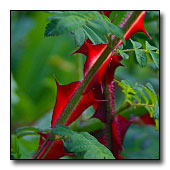
Quick Jumps
Growing Guide
Rainy Side Notes
GROWING GUIDE
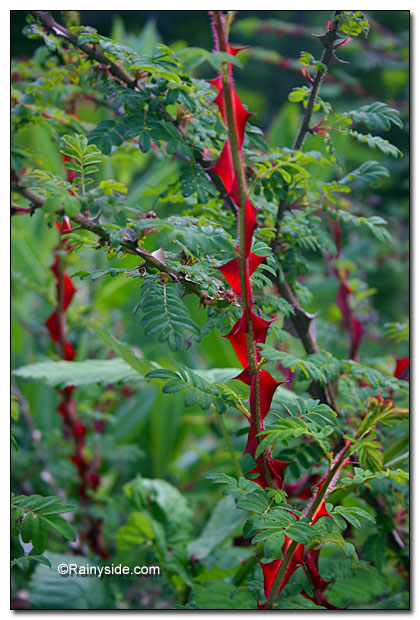
Origin:
Himalaya, China.
Plant Group:
Shrubs.
Hardiness:
Sunset zones: 3b-11.
USDA zones: 6-9.
Heat zones: 9-6.
Mature size:
Height: 8 feet (2.5 m).
Width: 7 feet (2.2 m).
Flowering period:
April to May.
Flowering attributes:
Single, white, fragrant flowers with 4 petals, followed by red hips in autumn.
Leaf attributes:
The small, elliptic and oblong leaflets are in groups of 11-17 along a stem, giving it a fern-like appearance.
Growth habit:
Upright shrub.
Light:
Full sun.
Soil:
Fertile, humus rich, well-drained soil.
Feeding:
Once a month with a complete organic fertilizer during growing season.
Propagation Methods:
Sow seed in containers in autumn and place in coldframe over winter.
Softwood cuttings during first flush of flowers.
Hardwood cuttings in autumn.
Layer stems for one year.
Divide suckers when dormant.
Pruning Methods:
Lightly prune immediately after flowering. Some gardeners advise pruning heavily in late winter for more red prickles on new growth. However, pruning hard means you lose the abundant white flowers in spring and its beautiful natural v-shape.
Rainy Side Notes
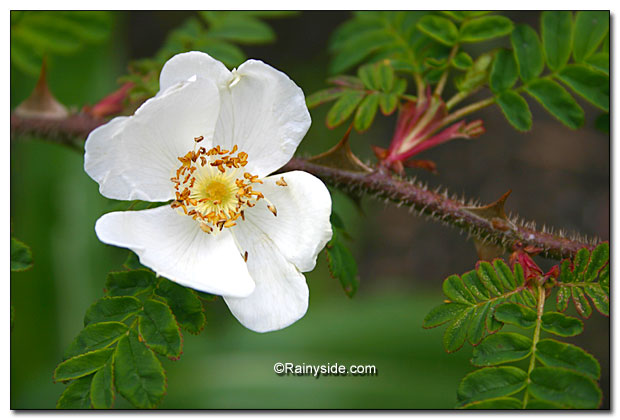
When I first glimpsed the flat, bright red, translucent prickles on this rose, it was backlit by the sun. An audible hiss escaped my lips as I sucked in my breath at the sight of those beautiful yet wicked-looking prickles. I braked immediately to a complete stop to inspect the shrub rose with its splendid scarlet-red menace. I wanted one for my garden, but finding one took me a few years. One afternoon, I was at a local nursery when I spotted it on a table and snatched it up quickly. I was so excited that I found one; I almost kissed my new treasure.
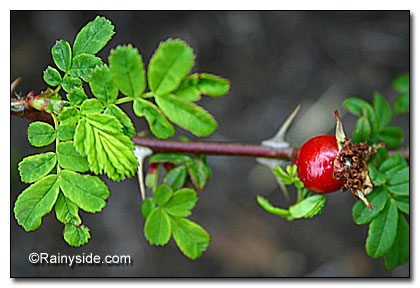
I carefully selected a place in the garden for this rose to grow. I wanted to highlight its attributes of long arching stems, full of one-inch wide, bright red prickles looking as if on fire, backlit by the late afternoon sun. To site it without backlighting does a disservice to the shrub and its primary attribute. Later in the season, the prickles turn dark and fade into the fern-like foliage. The flowers are unusual, too. Instead of having the usual five petals, it only has four.
Rosa sericea ssp. omeiensis f. pteracantha is a subspecies of R. sericea with more ornamental prickles than the latter species. Observing the hairy stems, you understand the name sericea—silky-hairy. The rose hips are edible. Caution: A layer of hair surrounding the seeds can irritate when eaten. Remove the hairs before consuming the fruit.
Since the plant is difficult to grow from cuttings, many of these species are sold grafted on other rootstock. If you have room in your garden and want to keep the rose's large, natural v-shape, keep pruning to a minimum. However, with little pruning, your shrub won't have as many red prickles.
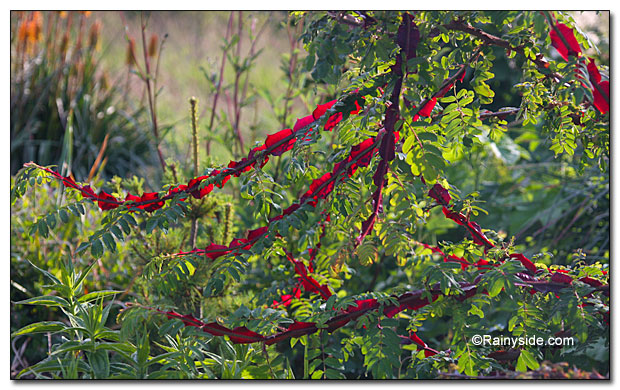
Photographed in author's garden.
A Pacific Northwest Plant of the Year (2013)

Gardening for the Homebrewer: Grow and Process Plants for Making Beer, Wine, Gruit, Cider, Perry, and More
By co-authors Debbie Teashon (Rainy Side Gardeners) and Wendy Tweton.

